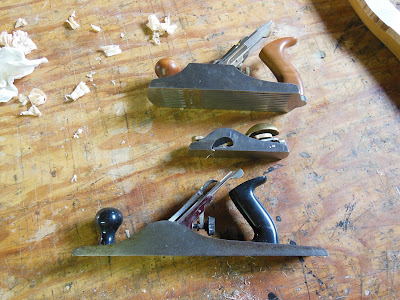Here are three hand planes that I use most often. The plane on top is a smoothing plane with a higher angle blade, fifty degrees, this helps reduce tearing on figured wood. The sole of this plane is corrugated which reduces suction on very smooth, planar surfaces. In the middle a little rabbeting, low angle block plane good for a lot of things, and good on end grain. The bottom plane is an inexpensive, old, but not antique, Stanley jack plane, that is re-sharpened with a convex curve in the iron, and with addition of small teeth. I use this plane for rough hogging or scrubbing of material. In the photo below you can see three soundboard panels in the drying room, the panel on the left shows the surface produced by this tool.
Photo below, detail of the surface, the curvature of the iron allows more material to be removed at a pass, while the teeth minimize tear-out. This panel is in the first stage of thicknessing. The panel in the middle has its final thickness, and is rough sanded.
Below the first stage in planing the Erard soundboard panel, in this instance I am starting with the smoother, rather than the scrub. The smoother if set up correctly will also take a pretty big bite.Below, the panel smooth on top, with some plane marks showing, these are then removed by scraping and sanding. It is normal for the panel to be prepared flat on the bottom, with any tapering being done to the top.
This panel has been in the conditioning room for about four weeks at 29 percent relative humidity, which translates to about 5-1/2 percent moisture content. The panel is returned to the drying room between workings. The next step is to fit the panel to instrument's case.







Comments
Post a Comment